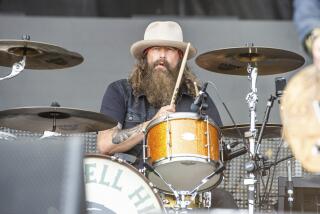Susanna Hoffs and friends remember David Roback, who stayed creative, and enigmatic, to the end

In David Roback’s final days, most of those closest to the late Mazzy Star co-founder were unaware that he’d been living with cancer. Although the music that the Los Angeles-born artist made with that band and earlier groups Opal and the Rain Parade was adored by millions, the famously reclusive artist, who died at 61 on Feb. 24, maintained a distance through his final breath.
Behind the scenes, though, friends say that Roback was actively contemplating his legacy by working to ensure that the mesmerizing, delicately layered rock music he made over the decades with collaborators including Kendra Smith, Hope Sandoval and Susanna Hoffs would survive him. Most, though, didn’t know he was dying.
Long a resident of Norway and London with his wife, Hedi Raikamo, the couple had quietly resettled near where he grew up in Brentwood about five years ago. A masterful producer and guitarist, Roback spent his creative energy working on a new batch of Mazzy Star recordings while remastering and preparing the release of archival music by his former band Opal.
“David just never stopped creating music. That was what he did,” says Frank Gironda of Lookout Management, who represented Mazzy Star for 30 years.
In a statement posted to Mazzy Star’s Facebook page, Sandoval included a poem and wrote, “It’s been a few days since I lost my dear friend and I am devastated... Thank you all for the love. Hope.”

In Roback’s last missive to his lifelong friend Susanna Hoffs of the Bangles, they texted about the possibility of making available “Rainy Day,” Roback’s 1983 collaborative album of cover songs featuring Hoffs, Smith and others singing influential works by artists including Big Star, Bob Dylan and the Velvet Underground. Hoffs and Roback started their first band together, the Unconscious, in the late 1970s.
Recalling Roback during a recent conversation, Hoffs paused to search her phone for the message.
Her voice breaking, Hoffs recited his words: “I’m very proud of the music we made together,” he wrote, adding multiple exclamation points. Reading his message aloud regarding the possible “Rainy Day” reissue, she said Roback wrote that he was “very interested, especially if it’s under our name the Unconscious. I think we have enough audio-visual material to do something very cool.’” Roback closed the message with a series of balloon emojis.
The Hoffs and Roback families grew up a few blocks away from each other in Brentwood (both of their fathers were doctors). She and Roback went to the same grade school and attended arts camp together in high school; Hoffs’ older brother John was Roback’s age, and his best friend.
“There was a side to him that was very mysterious in certain ways, in terms of his public persona. But I knew him as a mischievous child and a friend,” Susanna says.
Roback met one of his earliest musical collaborators, Matt Piucci, while both were attending Carleton College in Minnesota. Each was looking for a new dorm mate. “I walk into this guy’s room and I see the huge Jimi Hendrix poster and the American flag and he’s playing the Doors. I’m like, ‘OK, we’re going to get along,’” Piucci says.

Both left Carleton before graduation. Roback eventually landed at University of California, Berkeley’s art school. Hoffs and her brother John were also in Berkeley. Soon Hoffs and Roback were living together in what she calls “this incredible apartment, a Victorian house that had been made into two separate units.” She described the setting as “a sort of think tank for our burgeoning idea of being artists.” Hoffs still has a box full of recordings they made together.
The romantic relationship didn’t last, and both returned to L.A. in the early ‘80s. Roback reconnected with Piucci. Not long after, they formed the Rain Parade with David’s younger brother Steven and started rehearsing. With bands including the Dream Syndicate, the Three O’Clock, the Bangles and Green on Red working the circuit, a new sound was spreading through Hollywood, one featuring jangly Rickenbacker guitars that rang like the Byrds but was propelled by the DIY spirit of punk. The scene was dubbed the paisley underground.
Roback was ambitious from the start. The first time he saw Hoffs’ pre-Bangles group the Colours was at a party in the Hollywood Hills. Piucci recalls the band being so good that Roback nearly broke down, and eventually turned the experience into the Rain Parade’s first single. “David lost it. He was crying,” Piucci says. “He couldn’t take that his friend was going to be more successful than him right off the bat. So we wrote ‘What She’s Done to Your Mind.’”
While recording and touring in support of the Rain Parade’s debut album, “Emergency Third Rail Power Trip,” which featured songs written or co-written by Piucci and both David and Steven Roback, Piucci had a series of realizations about his creative partners. “First, that David didn’t get along with his brother,” Piucci says. “And [that] having three songwriters in the band was going to be really hard.” Steven did not reply to a request for an interview.
Piucci kicked David out of the Rain Parade, and the pair’s relationship never recovered. “That dude was going to be a famous artist no matter what, if it killed him,” says Piucci. “That’s what he wanted and he wanted it desperately. And he got it. And when people do that, there’s usually some collateral damage. Let’s just leave it at that.”
Even before the split, Roback had been working on a passion project, “Rainy Day.” Recorded for the Rain Parade’s Llama Records imprint, the musical love letter to lesser-known songs of the 1960s and ‘70s featured contributions by musicians from the paisley underground scene.

Hoffs sang on the renditions of Dylan’s “I’ll Keep It With Mine” and the Velvet Underground’s “I’ll Be Your Mirror.” She calls the experience of recording those formative songs “profound.”
Another featured singer on “Rainy Day” became Roback’s collaborator in Opal. Roback and Kendra Smith started a band after enlisting the late drummer Keith Mitchell and keyboard player Suki Ewers to record a set of singles, at first under the name Clay Allison.
Ewers had just moved south from Seattle when she answered a classified ad in LA Weekly. Identifying themselves as former members of the Rain Parade and Dream Syndicate, the musicians wrote that they were looking for a keyboard player. Ewers left a message on their answering machine.
“Literally the next day there was a knock on my door,” Ewers says. “It was Kendra.” Ewers remained a key member of Roback’s musical family up until his death, and played with him longer than anyone. She spent countless hours with him in the studio and on tour. (Smith declined to be interviewed for this story.)
Though Opal didn’t sell many records in its brief life, it got plenty of ink in taste-making fanzines including Forced Exposure, the Bob and Bucketful of Brains. It didn’t hurt that Opal’s label, SST Records, was gaining attention with bands including Sonic Youth, Hüsker Dü and Dinosaur Jr.
Ewers kept playing with Roback after Smith left Opal during a 1987 U.S. tour, and remained a key instrumentalist after Sandoval joined Opal soon thereafter.
Renaming themselves Mazzy Star, Sandoval and Roback earned immediate acclaim upon the release of their 1990 debut, “She Hangs Brightly.” Capitol Records financed the duo’s follow-up platinum smash, “So Tonight That I Might See,” which generated a devoted fan base through its richly textured hits “Fade Into You” and “Blue Flower.” After a hiatus, Sandoval and Roback returned to their Mazzy Star project starting in the early ‘10s.
As a collaborator and producer, Roback was “particular about things in a certain way, but he was also really open,” Ewers says, adding that the musicians that Roback stuck with had an “intuitive connection, musically. With a lot of the stuff, how we would play together was more like being in a jazz band. You really had to be in tune.”
Ewers learned of Roback’s death while she was out of town. “I was shocked,” she says. They’d talked earlier in February and he seemed fine. They’d made plans to continue working on new Mazzy Star material in March.
Hoffs, too, was blindsided by Roback’s death, even if she’d noticed a physical change in her friend. Since Roback and his wife had returned to Los Angeles, Hoffs had seen him a number of times. During a trio of 2016 Bangles performances at the Whisky a Go Go, Roback watched the set from the side of the stage. He came to her brother’s 60th birthday party.
“I had a fleeting thought a couple of times when I would just be sitting there and he looked thin,” she says. “But I didn’t know. He didn’t want me to know.”

If Roback hid his illness from many of his friends and associates, behind the scenes he was actively working to ensure that his music would not be forgotten. Although the work that he and Sandoval made as Mazzy Star remains available, Roback’s earlier records with Opal and for “Rainy Day” has been out of print for decades. Opal’s only studio album, 1987’s “Happy Nightmare Baby,” as well as a collection of singles and extant recordings, is unavailable on streaming services, and used copies command high dollar.
The reissue producer Pat Thomas, who manages Smith, says that Roback reached out via email a few years ago to begin the process of reintroducing Opal to the world. “David, for reasons known only to him, has kept those Opal records out of print forever,” Thomas says. “He finally came to us and said, ‘I think I’m ready to do this.’ But in David’s special fashion, what might have taken someone else three or four months took several years.”
That time was spent remastering “Happy Nightmare Baby” and “Early Years.” Thomas communicated with Roback across the reissue process mostly through email. In February, Thomas finalized the details of the Opal reissues with Roback’s Lookout Management.
A few days later, he got a call from Gironda telling them that Roback had died. “Kendra and I both kind of went into shock, because we just had no idea. I think it was very private that he had cancer.” Thomas now believes that Roback strategically held back the Opal releases and that “he wanted these to come out, perhaps, after his passing.”
Gironda confirms that the Opal reissues are on the way, and hopes that they’ll be released “sometime this year.” He adds that Roback and Sandoval kept meticulous Mazzy Star archives, and that a bounty of music from across their musical lives is secure and lies in wait.
Sandoval alluded to posthumous releases during a 2015 interview with the British magazine Uncut: “Once our families inherit everything after we’re dead and gone, I’m sure people will hear everything.”
As of yet, there are no plans for a public memorial service. That shouldn’t come as a surprise to anyone who knew him.
More to Read
The biggest entertainment stories
Get our big stories about Hollywood, film, television, music, arts, culture and more right in your inbox as soon as they publish.
You may occasionally receive promotional content from the Los Angeles Times.







